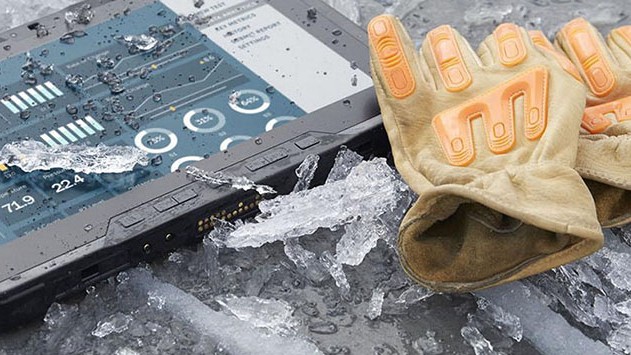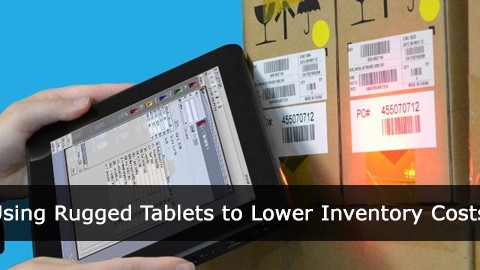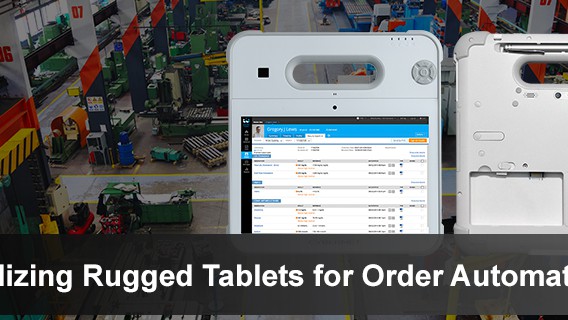Though it often gets overlooked in our day-to-day lives, logistics – or the systems that move goods and materials from place to place – is essentially the economy’s operating system. After all, the logistics industry is responsible for ensuring the goods we consume every day are in the right places at the right times. Just like on a computer, if the operating system is functioning as it’s supposed to, you barely notice it, but the entire machine can almost become unusable if the operating system malfunctions. In addition, the sheer volume of things that need to be transported across the world daily is staggering, requiring complex systems of people, vehicles, Industrial Tablets, and machines to manage.
With the pressure placed on labor by the restrictions of the COVID-19 pandemic coupled with the simultaneous global increase in online commerce and direct consumer shipping, keeping the logistics system running has never been more important. Thanks to an embrace of technology like Big Data Analysis, RFID, Robotics, and Rugged Industrial Tablets, the logistics industry has been able to keep the economy going even in these stressful times. This National Logistics Day, we look at the ways technology helps keep goods flowing across the globe.
Industrial Tablets, Tracking, & Tracing
Article Guide
One of the main functions of any logistics company is accurately tracking and routing each parcel as it makes its way from its origin to its final destination. As should be evident to any layperson, at scale, this is a herculean undertaking.
The Old Way
Before computers, this was accomplished utilizing a complicated pen and paper system. Whenever goods stopped at a waypoint in their journey, they needed to be manually logged by a laborer. Obviously, that system had massive built-in inefficiencies and was prone to frequent human error. If a package got lost, finding it would be exceedingly difficult in a world without computers.
The advent of computers and digital tracking technologies like barcodes in the last quarter of the 20th century massively increased the efficiency and accuracy of the parcel tracking and tracing system. Now, when goods arrived at a distribution center or other waypoint, workers could quickly scan the barcodes into a computer networked into a company-wide database.
However, despite being a massive improvement over the old pen and paper system, this system still has built-in inefficiencies and opportunities for human error. For example, bar codes need to be scanned one by one, often by hand, meaning it’s easy for packages to be missed and become impossible to recover if lost.
Not only that, but they are only scanned when they reach a computer at a fixed waypoint, meaning there’s no way to track goods while they’re in transit. Often, the difference between a package making it on time and not depends on which route the truck driver takes, and if you can’t see where packages are when they’re on the road, it becomes harder to guarantee your shipping times.
Industrial Tablets, GPS, and the Power of RFID
Today, with digital technology advancing even further, it’s becoming increasingly possible for logistics companies to close these remaining tracking and tracing inefficiencies. Unlike with barcodes, Radio Frequency Identification (RFID) technology makes it possible for a worker to use an Industrial Tablet or Industrial Panel PC equipped with a built-in RFID scanner to scan multiple packages at once from a single device. This saves massive amounts of time at waypoints and distribution centers while also reducing the chance that any individual package will be missed.
Modern logistics distribution centers are marvels of modern technology. Put simply; it would be impossible to manage the flow of goods without automation. With RFID, not only is it possible for humans to more quickly scan and route packages, but it is also easier for robots and machines to do so as well. While machines can certainly scan barcodes faster than humans, they still need to be scanned one at a time, and the parcel needs to be physically directly in front of the optical reader to be scanned. RFID makes it so your machinery can scan multiple packages in a single pass, regardless of how the parcel is oriented in relation to the scanner.
Industrial tablets also make it possible to track packages while they are en route instead of only being able to track the last stop where they were scanned. Because they can be customized with built-in 4G-LTE connectivity, it is possible to follow a tablet’s location using GPS and cell tower-based digital location technology. So now, instead of just receiving updates on packages when scanned, it’s possible to track parcels in transit by tracking the tablet it’s assigned to. This makes it easier for logistics companies to monitor their operations and puts customers’ minds at ease, knowing they can get real-time updates on their shipment whenever they want. This is a level of In-transit Visibility that had previously been impossible.
Tracking Isn’t Just About Packages
Another benefit of using GPS tracking capabilities afforded by Rugged Industrial Tablets is the ability to more directly control the routes truck drivers take and reroute shipments in transit. In addition, rugged industrial tablets are VESA mountable, meaning they can be easily mounted into the dash of any truck or similar vehicle.
In the past, the route a driver took was primarily up to their discretion. Now, they can use a GPS-enabled tablet to find the fastest possible route to each of their destinations. In addition, since GPS can respond to changing road conditions – closures, traffic, weather, etc. – in real-time, goods can be rerouted in an instant to prevent slowdowns. That way, a freak storm during rush hour doesn’t hold anything out.
Additionally, because it’s possible to track tablets as long as they are within range of a cell tower, it’s possible for supervisors to track their drivers. Should a driver choose to deviate from their GPS recommended route, their supervisor receives an alert to contact that driver and see what is going on.
Of course, the fact that VESA mounts for portable tablets are cheaper to install on a fleet of trucks and delivery vehicles than it is to hardwire each of them for GPS capabilities is just a cherry on top for logistics companies.
Final Thoughts
If you’re interested in seeing how Industrial Tablets can streamline your logistics operation, contact the experts at Cybernet today!
Why Choose Rugged Tablets over Consumer Tablets
January 12, 2016
As technology continues to play a more integral in the way companies operate, many are now opting to use mobile tablet computers for their business purposes. In fact, According to Quarterly Mobile PC Shipment and…
0 Comments4 Minutes
Using Rugged Tablets to Lower Inventory Costs
November 30, 2015
Managing your inventory is something you can’t afford to mishandle. Wasting time and money through outdated processes is a way to quickly ruin a business. The expression “if it’s not broken, don't fix it” doesn’t always…
0 Comments4 Minutes
Utilizing Rugged Tablets for Order Automation
June 21, 2016
Regardless of the products that a company produces and distributes, the process of completing orders is always very similar. Orders come in, often in a variety of formats, including email, fax, phone, and online forms.…
0 Comments6 Minutes
You Can't
Learn from a Pop-up
But we can deliver knowledge to your inbox!
We dive deep in the industry looking for new trends, technology, news, and updates. We're happy to share them with you.
Knowledge, News, and Industry Updates Right in Your Inbox





